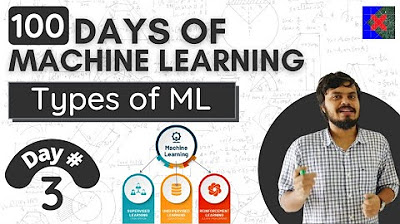GEOMETRIC MODELS ML(Lecture 7)
Summary
TLDRThis lecture introduces geometric models in machine learning, focusing on how features can be visualized as points in space to solve problems through linear regression, classification, SVM, nearest neighbor, and clustering. It explains how linear regression predicts a target variable based on input features, and how binary linear classification uses a threshold to categorize data. The lecture also touches on the limitations of geometric models in high-dimensional spaces and the importance of distance metrics in KNN and clustering algorithms, setting the stage for further exploration of probabilistic models.
Takeaways
- 📚 The lecture focuses on geometric models in machine learning, which include linear regression, linear classification, SVM, nearest neighbor, and clustering.
- 📈 Geometric models treat features as points in a space, where the dimensionality corresponds to the number of features.
- 📊 Linear regression is used for predicting a target variable based on input features, aiming to minimize the error between predicted and actual values.
- 🔍 Exploratory analysis involves visualizing data to understand the relationship between variables, which can be linear or non-linear.
- 🤖 For non-linear relationships, non-linear regression models are used to better fit the data.
- 🔢 In geometric models, similarity can be imposed through linear boundaries (like lines or planes) or through distance metrics.
- 📉 Linear classification uses a linear boundary to separate different classes of data, with the decision boundary determined by the difference between class centroids.
- 📌 Support Vector Machines (SVM) are a type of geometric model that use distance measures to create a decision boundary with the largest margin between classes.
- 👥 The k-nearest neighbors (KNN) algorithm classifies new data points based on the labels of their nearest neighbors, using distance metrics to determine closeness.
- 🔍 Clustering algorithms, such as k-means, group data points based on their distances to centroids, aiming to minimize the distance within each cluster while maximizing the distance between clusters.
Q & A
What are the three types of models discussed in the script?
-The three types of models discussed are geometric models, probabilistic models, and logical models.
How are features represented in geometric models?
-In geometric models, features are represented as points in a space where the dimensions correspond to the number of features. For instance, two features would be represented in a two-dimensional space.
What is the simplest geometric model mentioned for predicting a target variable?
-The simplest geometric model mentioned for predicting a target variable is linear regression.
How does the script describe the process of linear regression?
-Linear regression is described as a method to find a line that best fits the data points in a graph, minimizing the error by using squared errors to ensure all values are positive.
What is the significance of the bias term in the context of linear regression?
-The bias term, represented as 'B', is part of the linear regression equation and represents the intercept of the line on the Y-axis, adjusting the model's predictions.
How does the script explain the concept of a loss function in machine learning?
-The script explains the loss function as a measure of error for each prediction, where the sum of squared errors is used to represent the loss, and minimizing this loss is the goal.
What is the difference between a loss function and a cost function as described in the script?
-A loss function is the error for each individual prediction, while a cost function is the average error across all training examples, representing the overall performance of the model.
How does the script define an instance space in the context of geometric models?
-The instance space is defined as the combination of all possible instances of features, where each instance is a unique combination of feature values.
What is the role of distance in geometric models as discussed in the script?
-In geometric models, distance is used as a measure to classify or cluster points based on their proximity to other points or centroids, as seen in k-nearest neighbors and clustering algorithms.
Why might linear classification fail according to the script?
-Linear classification might fail when the instance space is mostly empty, meaning there are very few points that can be used to create a meaningful boundary for classification.
How does the script describe the process of clustering in geometric models?
-Clustering in geometric models is described as a process where points are grouped into clusters based on their distance from a centroid, with the centroids being adjusted iteratively until convergence.
Outlines

Этот раздел доступен только подписчикам платных тарифов. Пожалуйста, перейдите на платный тариф для доступа.
Перейти на платный тарифMindmap

Этот раздел доступен только подписчикам платных тарифов. Пожалуйста, перейдите на платный тариф для доступа.
Перейти на платный тарифKeywords

Этот раздел доступен только подписчикам платных тарифов. Пожалуйста, перейдите на платный тариф для доступа.
Перейти на платный тарифHighlights

Этот раздел доступен только подписчикам платных тарифов. Пожалуйста, перейдите на платный тариф для доступа.
Перейти на платный тарифTranscripts

Этот раздел доступен только подписчикам платных тарифов. Пожалуйста, перейдите на платный тариф для доступа.
Перейти на платный тарифПосмотреть больше похожих видео

All Machine Learning Models Clearly Explained!

All Machine Learning algorithms explained in 17 min

All Learning Algorithms Explained in 14 Minutes

Types of Machine Learning for Beginners | Types of Machine learning in Hindi | Types of ML in Depth

Week 2 Lecture 6 - Statistical Decision Theory - Classification

Bayesian Estimation in Machine Learning - Introduction and Examples
5.0 / 5 (0 votes)
